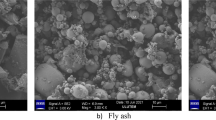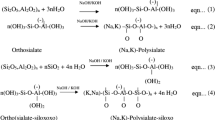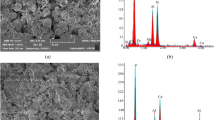Abstract
The thermal and mechanical properties of sustainable lightweight engineered geopolymer composites (EGCs), exhibiting strain-hardening behavior under uniaxial tension, are reported in this study. Fly ash-based geopolymer was used as complete replacement of cement binder to significantly increase the environmental sustainability of the composite compared to the engineered cementitious composite (ECC). Additionally, three types of lightweight aggregates including expanded perlite, microscopic hollow ceramic spheres and expanded recycled glass were used as complete replacement of micro-silica sand to reduce density and thermal conductivity of the composite. The influences of the type of aggregates on the fresh and hardened properties of the composite including matrix workability, density, compressive strength, thermal conductivity and uniaxial tensile performance were experimentally evaluated. The results indicated that the density and compressive strength of all EGCs developed in this study, even the EGC containing normal weight micro-silica sand, were less than 1833 kg/m3 and more than 43.4 MPa, respectively, meeting the density and compressive strength requirements for structural lightweight concrete. Replacing normal weight micro-silica sand with lightweight aggregates reduced the compressive and tensile strengths of the EGCs by a maximum of 24% and 32%, respectively. However, the tensile ductility of the EGCs containing lightweight aggregates was comparable to that of the EGC containing micro-silica sand. In addition, the thermal conductivity of the EGCs containing lightweight aggregates were significantly (38–49%) lower than that of the EGC containing normal weight micro-silica sand, resulting in an end-product that is greener, lighter, and provides better thermal insulation than ECC.
Similar content being viewed by others
References
ACI 213R, ACI Committee 231. Guide for structural lightweight-aggregate concrete, 2014.
S. Chandra, L. Berntsson, Lightweight Aggregate Concrete: Science, Technology and Applications, William Andrew Publishing, New York, 2002.
S. Wang, V.C. Li, Lightweight engineered cementitious composites (ECC), in: Proceedings of 4th International RILEM Workshop on High Performance Fiber Reinforced Cement Composites (HPFRCC 4), vol. 1, 2003, 379–390.
R. Hengst, R. Tressler, Fracture of foamed Portland cements, Cement and Concrete Research 13 (1) (1983) 127–134.
M.H. Zhang, O.E. Gjvorv, Mechanical properties of high-strength lightweight concrete, ACI Materials Journal 88 (3) (1991) 240–247.
J. Gao, W. Sun, K. Morino, Mechanical properties of steel fiber-reinforced, high-strength, lightweight concrete, Cement and Concrete Composites 19 (4) (1997) 307–313.
S.B. Park, E.S. Yoon, B.I. Lee, Effects of processing and materials variations on mechanical properties of lightweight cement composites, Cement and Concrete Research 29 (2) (1999) 193–200.
V.C. Li, H.-C. Wu, Conditions for pseudo strain-hardening in fiber reinforced brittle matrix composites, Applied Mechanics Review 45 (8) (1992) 390–398.
E.-H. Yang, Y. Yang, V.C. Li, Use of high volumes of fly ash to improve ECC mechanical properties and material greenness, ACI Materials Journal 104 (6) (2007) 620–628.
V.C. Li, T. Kanda, Innovations forum: engineered cementitious composites for structural applications, ASCE Journal of Materials in Civil Engineering 10 (2) (1998) 66–69.
X. Huang, R. Ranade, Q. Zhang, W. Ni, V.C. Li, Mechanical and thermal properties of green lightweight engineered cementitious composites, Construction and Building Materials 48 (2013) 954–960.
X. Huang, R. Ranade, V.C. Li, Feasibility study of developing green ECC using iron ore tailings powder as cement replacement, Journal of Materials in Civil Engineering 25 (7) (2012) 923–931.
J.-K. Kim, J.-S. Kim, G.J. Ha, Y.Y. Kim, Tensile and fiber dispersion performance of ECC (engineered cementitious composites) produced with ground granulated blast furnace slag, Cement and Concrete Research 37 (7) (2007) 1096–1105.
B. Nematollahi, J. Sanjayan, F.U.A. Shaikh, Synthesis of heat and ambient cured one-part geopolymer mixes with different grades of sodium silicate, Ceramics International 41 (4) (2015) 5696–5704.
J. Davidovits, Geopolymers: inorganic polymeric new materials, Journal of Thermal Analysis 37 (8) (1991) 1633–1656.
J.L. Provis, Modelling the formation of geopolymers, (PhD Thesis), Chemical & Biomolecular Engineering, University of Melbourne, 2006.
B. Nematollahi, J. Sanjayan, Efficacy of available superplasticizers on geopolymers, Research Journal of Applied Sciences, Engineering and Technology 7 (7) (2014) 1278–1282.
B. Nematollahi, J. Sanjayan, J.X.H. Chai, T.M. Lu, Properties of fresh and hardened glass fiber reinforced fly ash based geopolymer concrete, Key Engineering Materials 594 (2014) 629–633.
Z. Li, Z. Ding, Y. Zhang, Development of sustainable cementitious materials, in: Paper Presented at the Proceedings of the International Workshop on Sustainable Development and Concrete Technology, 2004.
P. Duxson, J.L. Provis, G.C. Lukey, J.S. Van Deventer, The role of inorganic polymer technology in the development of ’green concrete’, Cement and Concrete Research 37 (12) (2007) 1590–1597.
U.S. Department of Energy, Buildings energy data book, 2010 Retrieved from http://buildingsdatabook.eren.doe.gov/docs%5CDataBooks%5C2010_BEDB.pdf.
B. Nematollahi, J. Sanjayan, F.U.A. Shaikh, Tensile strain hardening behavior of PVA fiber-reinforced engineered geopolymer composite, ASCE Journal of Materials in Civil Engineering 27 (10) (2015) 04015001.
B. Nematollahi, J. Sanjayan, F.U.A. Shaikh, Strain hardening behavior of engineered geopolymer composites: effects of the activator combination, Journal of Australian Ceramic Society 51 (1) (2015) 54–60.
B. Nematollahi, J. Sanjayan, F.U.A. Shaikh, Comparative deflection hardening behavior of short fiber reinforced geopolymer composites, Construction and Building Materials 70 (2014) 54–64.
B. Nematollahi, J. Sanjayan, F.U.A. Shaikh, Influence of the type of activator combinations on the deflection hardening behavior of geopolymer composites, in: SHCC3 - 3rd International RILEM Conference on Strain Hardening Cementitious Composites, 3-5 November, Dordrecht, The Netherlands, RILEM Publications S.A.R.L., 2014 105–112.
B. Nematollahi, J. Sanjayan, F.U.A. Shaikh, Influence of matrix related parameters on strain hardening behavior of engineered geopolymer composite (EGC), in: Concrete 2015 - The 27th Biennial National Conference of the Concrete Institute of Australia in Conjunction with the 69th RILEM Week Conference, 30 August-2 September, Melbourne, Australia, 2015.
B. Nematollahi, J. Sanjayan, F.U.A. Shaikh, Matrix design of strain hardening fiber reinforced engineered geopolymer composite, Composites Part B: Engineering 89 (2016) 253–265.
D.L. Kong, J.G. Sanjayan, Effect of elevated temperatures on geopolymer paste, mortar and concrete, Cement and Concrete Research 40 (2) (2010) 334–339.
D. Hardjito, S.E. Wallah, D.M. Sumajouw, B.V. Rangan, On the development of fly ash-based geopolymer concrete, ACI Materials Journal 101 (6) (2014) 467–472.
B. Nematollahi, J. Sanjayan, Effect of different superplasticizers and activator combinations on workability and strength of fly ash based geopolymer, Material and Design 57 (2014) 667–672.
H. Okamura, K. Ozawa, Mix design for self-compacting concrete, Concrete Library JSCE 25 (6) (1995) 107–120.
ASTM C109/C109 M, Standard test method for compressive strength of hydraulic cement mortars (using 50 mm [2 in.] cube specimens), ASTM Standards, United States, 2007.
J. Cha, J. Seo, S. Kim, Building materials thermal conductivity measurement and correlation with heat flow meter, laser flash analysis and TCi, Journal of Thermal Analysis and Calorimetry 109 (1) (2011) 295–300.
Poraver Technical Specifications [Online]. Dennert Poraver GmbH. Available: http://www.poraver.com/us/products/technical-data/ (accessed 20.02.15).
E-SPHERES Technical Specifications [Online]. Envirospheres Pty Ltd. Available: http://www.envirospheres.com/products_bl.asp (accessed 10.02.15).
V.C. Li, M. Lepech, S. Wang, M. Weimann, G. Keoleian, Development of green ECC for sustainable infrastructure system, in: Proceedings of International Workshop on Sustainable Development and Concrete Technology, Iowa State Univ., Ames, IA, (2004) 181–192.
B.C. McLellan, R.P. Williams, J. Lay, A. Van Riessen, G.D. Corder, Costs and carbon emissions for geopolymer pastes in comparison to ordinary Portland cement, Journal of Cleaner Production 19 (9) (2011) 1080–1090.
M. Fawer, M. Concannon, W. Rieber, Life cycle inventories for the production of sodium silicates, International Journal of Life Cycle Assessment 4 (4) (1999) 207–212.
Integrated Pollution Prevention and Control (IPPC), Reference Document on Best Available Techniques in the Chlor-Alkali Manufacturing Industry, European IPPC Bureau, 2001.
K.-H. Yang, J.-K. Song, K.-I. Song, Assessment of C02 reduction of alkali-activated concrete, Journal of Cleaner Production 39 (2013) 265–272.
National Greenhouse Accounts Factors, The Department of the Environment - Australian Government, 2014. Retrieved from http://www.environment.gov.au/.
V.C. Li, S. Wang, C. Wu, Tensile strain-hardening behavior of polyvinyl alcohol engineered cementitious composite (PVA- ECC), ACI Materials Journal 98 (6) (2001).
V.C. Li, Reflections on the research and development of engineered cementitious composites (ECC), in: Proceedings of DFRCC-2002, Takayama, Japan, (2002) 1–22.
TGS Industrial Sand Technical Specifications [Online]. T.G.S. Industrial Sands Pty. Ltd. Available: http://tgsindustrialsands.com.au/our-products/ (accessed 20.02.15).
Ausperl Technical Specifications [Online]. Australian Perlite Pty Limited (AUSPERL) Available: http://www.australianperlite.com/perlite/ (accessed 20.02.15).
T. Kanda, V.C. Li, Practical design criteria for saturated pseudo strain hardening behavior in ECC, Journal of Advanced Concrete Technology 4 (1) (2006) 59.
E.H. Yang, V.C. Li, Strain-hardening fiber cement optimization and component tailoring by means of a micromechanical model, Construction and Building Materials 24 (2) (2010) 130–139.
V. Li, D. Mishra, H.-C. Wu, Matrix design for pseudo-strain-hardening fiber reinforced cementitious composites, Materials and Structures 28 (1995) 586–595.
B.Y. Lee, C.-G. Cho, H.-J. Lim, J.-K. Song, K.-H. Yang, V.C. Li, Strain hardening fiber reinforced alkali-activated mortar - a feasibility study, Construction and Building Materials 37 (2012) 15–20.
R. Demirboga, R. Gill, The effects of expanded perlite aggregate, silica fume and fly ash on the thermal conductivity of lightweight concrete, Cement and Concrete Research 33 (5) (2003) 723–727.
C.J.M. Lasance, The thermal conductivity of silicon dioxide, Electronics Cooling August (2004).
Author information
Authors and Affiliations
Corresponding author
Rights and permissions
About this article
Cite this article
Nematollahi, B., Ranade, R., Sanjayan, J. et al. Thermal and mechanical properties of sustainable lightweight strain hardening geopolymer composites. Archiv.Civ.Mech.Eng 17, 55–64 (2017). https://doi.org/10.1016/j.acme.2016.08.002
Received:
Accepted:
Published:
Issue Date:
DOI: https://doi.org/10.1016/j.acme.2016.08.002




